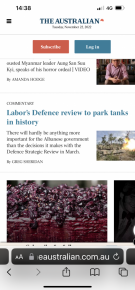The suggestion started as a proposal during the last parliament that some or all of the OPVs be armed due to a need perceived as part of our worsening strategic outlook.
In the current parliament the consideration of a corvette, potentially being a more cost effective and capable solution became part of the discussion. The K130 or a derivative thereof was mentioned as it, like the Arafura class OPV, is a product of Lurssen, who currently have a relationship with Australia as a designer.
During this period, Navantia, who made an unsolicited offer of three additional AEGIS ships, added an offer for six corvettes. Navantia of course also have a relationship with Australia.
This appears to be a case of investigations being made into how much extra bang can we get, and when, for our buck, by repurposing existing relationships, materials and equipment.
Other options fall outside of this scope.
Would the RAN be happier if they were told they were getting six Flight III Burke's by 2030, you bet cha! Are they going to get them, not in our current reality, would they be happy with six missile corvettes in place of six stock OPVs, of course. Will they care if they have the same range as the Arafuras and Capes, probably not.
In the current parliament the consideration of a corvette, potentially being a more cost effective and capable solution became part of the discussion. The K130 or a derivative thereof was mentioned as it, like the Arafura class OPV, is a product of Lurssen, who currently have a relationship with Australia as a designer.
During this period, Navantia, who made an unsolicited offer of three additional AEGIS ships, added an offer for six corvettes. Navantia of course also have a relationship with Australia.
This appears to be a case of investigations being made into how much extra bang can we get, and when, for our buck, by repurposing existing relationships, materials and equipment.
Other options fall outside of this scope.
Would the RAN be happier if they were told they were getting six Flight III Burke's by 2030, you bet cha! Are they going to get them, not in our current reality, would they be happy with six missile corvettes in place of six stock OPVs, of course. Will they care if they have the same range as the Arafuras and Capes, probably not.



